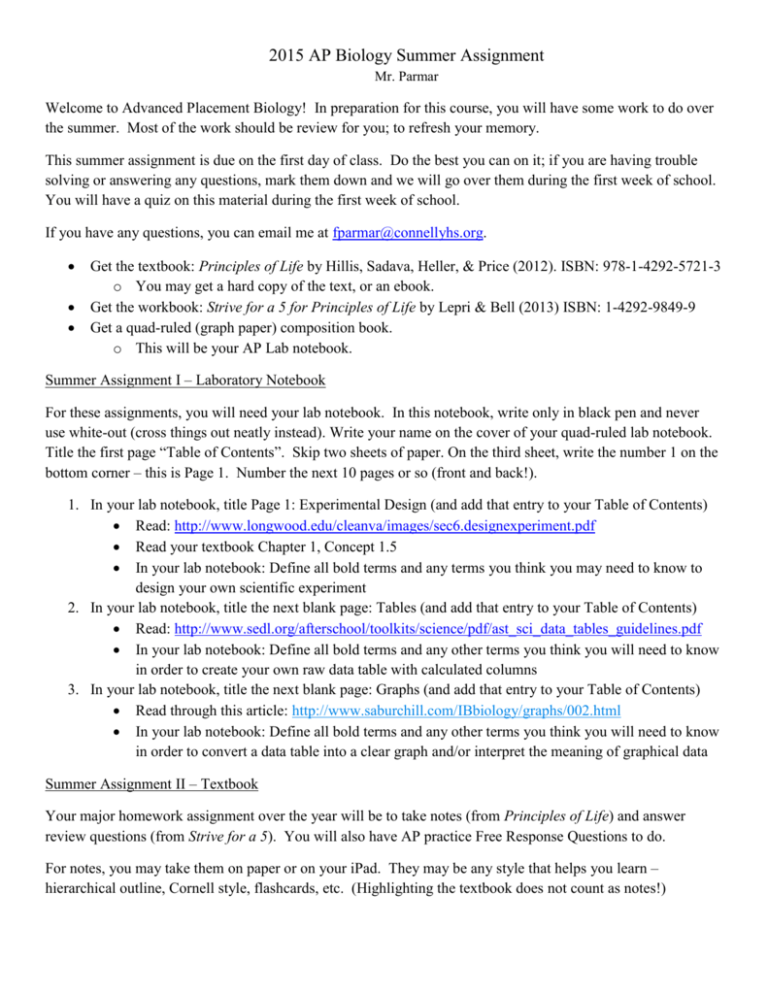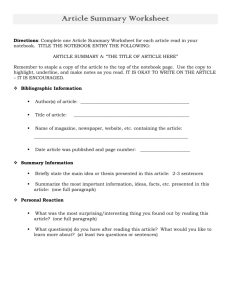AP Biology - Cornelia Connelly School
advertisement

2015 AP Biology Summer Assignment Mr. Parmar Welcome to Advanced Placement Biology! In preparation for this course, you will have some work to do over the summer. Most of the work should be review for you; to refresh your memory. This summer assignment is due on the first day of class. Do the best you can on it; if you are having trouble solving or answering any questions, mark them down and we will go over them during the first week of school. You will have a quiz on this material during the first week of school. If you have any questions, you can email me at fparmar@connellyhs.org. Get the textbook: Principles of Life by Hillis, Sadava, Heller, & Price (2012). ISBN: 978-1-4292-5721-3 o You may get a hard copy of the text, or an ebook. Get the workbook: Strive for a 5 for Principles of Life by Lepri & Bell (2013) ISBN: 1-4292-9849-9 Get a quad-ruled (graph paper) composition book. o This will be your AP Lab notebook. Summer Assignment I – Laboratory Notebook For these assignments, you will need your lab notebook. In this notebook, write only in black pen and never use white-out (cross things out neatly instead). Write your name on the cover of your quad-ruled lab notebook. Title the first page “Table of Contents”. Skip two sheets of paper. On the third sheet, write the number 1 on the bottom corner – this is Page 1. Number the next 10 pages or so (front and back!). 1. In your lab notebook, title Page 1: Experimental Design (and add that entry to your Table of Contents) Read: http://www.longwood.edu/cleanva/images/sec6.designexperiment.pdf Read your textbook Chapter 1, Concept 1.5 In your lab notebook: Define all bold terms and any terms you think you may need to know to design your own scientific experiment 2. In your lab notebook, title the next blank page: Tables (and add that entry to your Table of Contents) Read: http://www.sedl.org/afterschool/toolkits/science/pdf/ast_sci_data_tables_guidelines.pdf In your lab notebook: Define all bold terms and any other terms you think you will need to know in order to create your own raw data table with calculated columns 3. In your lab notebook, title the next blank page: Graphs (and add that entry to your Table of Contents) Read through this article: http://www.saburchill.com/IBbiology/graphs/002.html In your lab notebook: Define all bold terms and any other terms you think you will need to know in order to convert a data table into a clear graph and/or interpret the meaning of graphical data Summer Assignment II – Textbook Your major homework assignment over the year will be to take notes (from Principles of Life) and answer review questions (from Strive for a 5). You will also have AP practice Free Response Questions to do. For notes, you may take them on paper or on your iPad. They may be any style that helps you learn – hierarchical outline, Cornell style, flashcards, etc. (Highlighting the textbook does not count as notes!) For any questions that are assigned, all answers must be complete and concise. You generally do not need to write in full sentences (bullet points are ok) unless you are told otherwise. These questions will usually be assigned at the end of every chapter – you may have them as a separate document or as the end of every chapter’s notes; again, use a format that helps you remember and learn (and stay organized!) 1. Answer the following questions on a separate sheet of paper (not your lab notebook) or on your iPad. Use Chapter 1, Section 1 and Chapter 20, Section 1 to help you. Define prokaryote and eukaryote. Distinguish between prokaryotes and eukaryotes. What are the differences? One support for the endosymbiotic theory of eukaryote evolution is the fact that many organelles in the typical eukaryote have double membranes. Is this good proof of the endosymbiotic theory? Justify your answer. A scientist isolates several microbes from a sample of lake water. When looking at the sample under a microscope, he sees that the microbes are photosynthetic, green, slimy, and have no discernible internal structures. Are these prokaryotes or eukaryotes? Why? What are the steps in the endosymbiotic theory and the membrane infolding theories of eukaryotic evolution? Speculate on what might have happened to prokaryote / eukaryote evolution if photosynthesis had never evolved. 2. Read and take notes on Principles of Life Chapter 1 Answer the following questions for this chapter from Strive for a 5: #1, 2, 3, 4, 8, 11, 13, 14 3. Read and take notes on Principles of Life Chapter 2 On a separate sheet of paper, or on your iPad – answer the following questions for this chapter from Strive for a 5: # 1, 2, 4, 7, 8, 10, 13, 14, 15, 16 4. Read and take notes on Principles of Life Chapter 3 On a separate sheet of paper, or on your iPad – answer the following questions for this chapter from Strive for a 5: # 1, 3, 4, 7, 9, 10, 12, 13, 14, 16, 19, 20 Summer Assignment III – AP Exam Practice The AP Biology exam has two sections. Section I is worth 50% of the score and consists of various multiplechoice and grid-in questions. Section II of the Exam consists of Free Response Questions (FRQs) that involve graphing, calculations, analysis of data, and scientific writing. You will practice a long FRQ. Review Chapter 1 before starting. When ready, get a sharpened pencil and a blank sheet of lined paper (not in your lab notebook, and not on an iPad). You will also need a timer; set it to 20 minutes and answer the following FRQ. (Answer it as an essay – in full sentences, in paragraph format). 1. Despite the extreme diversity of life on Earth, several underlying principles can be used to guide Biologists in studying its forms. State at least four underlying principles that are generally recognized by Biologists. For each principle, explain how it can be generalized to most or all of the organisms on Earth. Give several examples of applications of the principles to support your claims.







